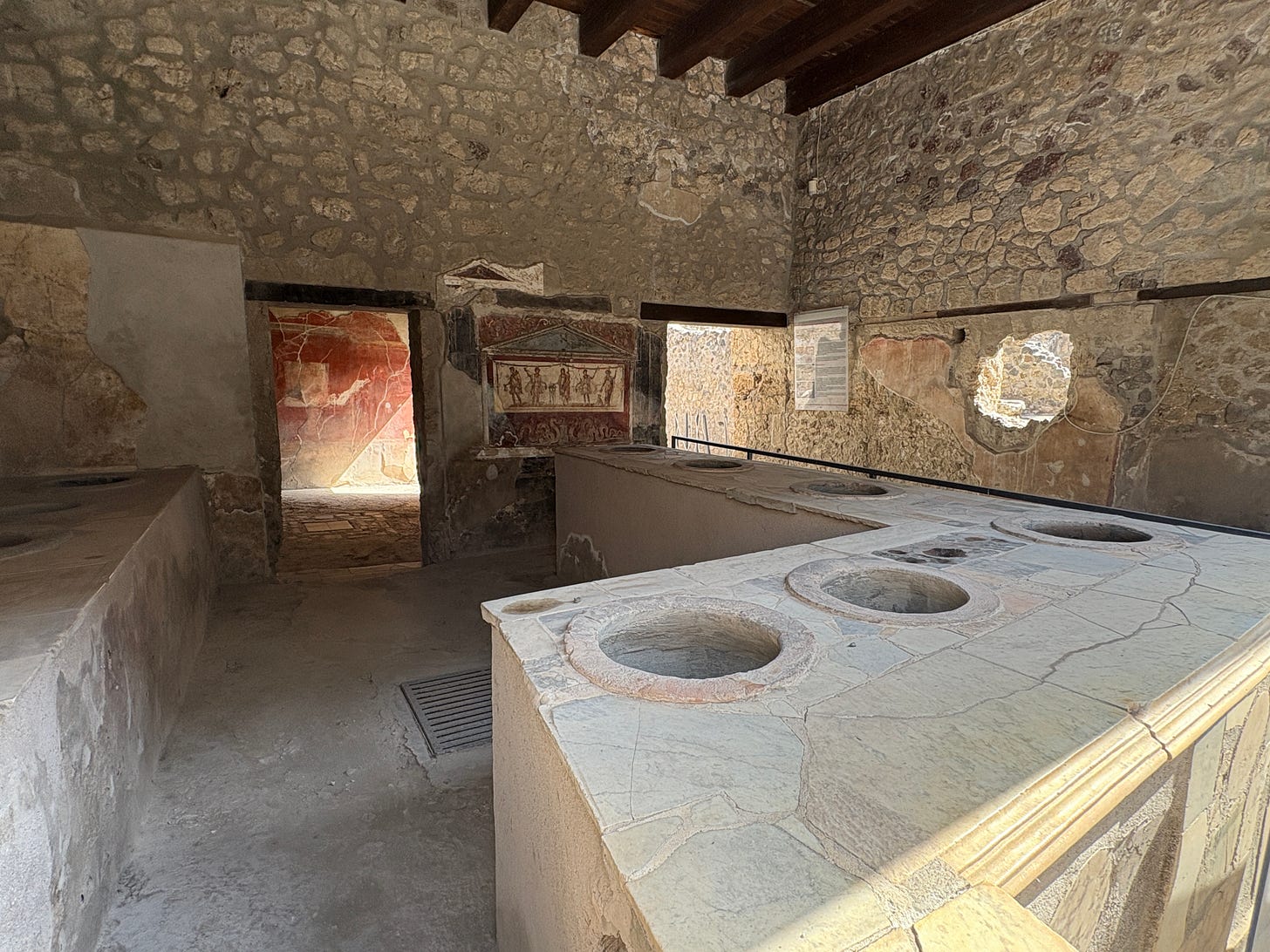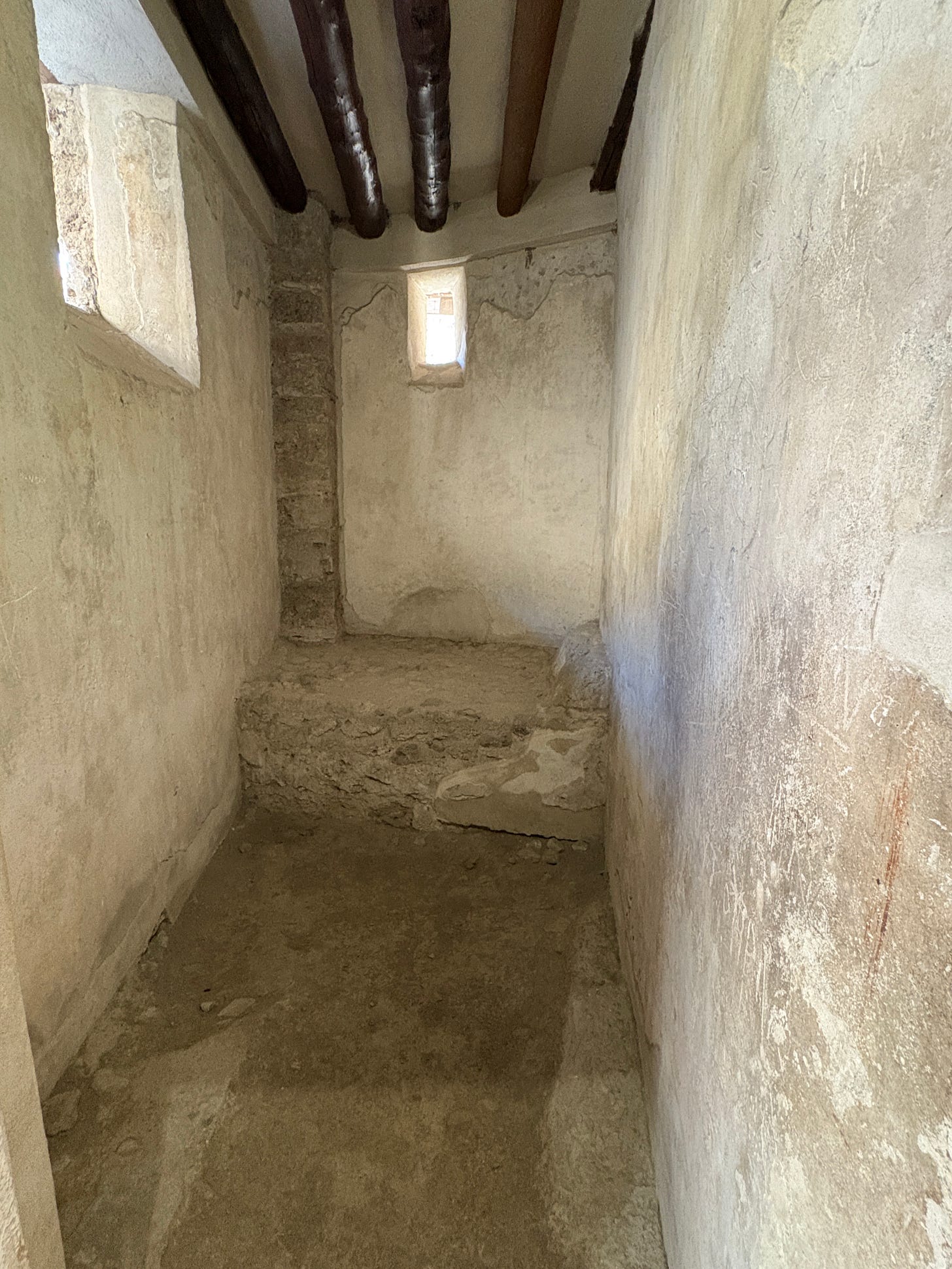I wrote these lines immediately after returning from Pompeii, trying to fix on paper the impressions of a summer afternoon among the ruins. This is not an essay, nor a guide. Just scattered notes, gathered while the dust was still on my shoes. I plan to return with more time and focus, but for now, I wanted to hold onto what had struck me the most, those details that escape the official reconstructions.
Pompeii is a name repeated endlessly. The bibliography is extensive and continues to grow. There are school trips (mine was in high school, and I mostly remember not sleeping at all because we stayed up all night), documentaries about the tragedy and the victims' final moments, Hollywood films with their tongues of fire and showers of ash.
And then there is the tourist brand: Pompeii, with a double "i", printed on T-shirts and magnets. It works. It sells.
But a quiet summer afternoon, with just a few heat-weary visitors, is enough to let something else emerge. The paved streets nearly empty. The great stones smoothed by time, still marked by the deep ruts left by carts that passed there again and again, until that day in 79 CE.
The ordinary becomes unfamiliar again.
I walk through the streets, and the prints of my soles blend with those of others: tourists, staff, archaeologists. Around me, languages mix: English, French, Japanese, Spanish, German... I hear broken phrases, comments, laughter, and, in the distance, the honking of tour buses.
Pompeii has lost its original voices, but still hosts voices from across the world.
In a stable uncovered in 1938, the remains of a horse were found and patiently reconstructed on a metal frame. The sign says it stood 1.40 meters at the withers. Its jaw was uneven due to an old injury, and two lumbar vertebrae had fused from wear. It mainly chewed on the left side of its teeth. A poor working animal he was.
Pompeii was not just villas and frescoes. It was also, and perhaps above all, the daily effort of living bodies.
In the so-called "Garden of the Fugitives," you can see the casts of thirteen people caught in the terror of their last moments, buried under more than three meters of pumice as they tried to escape. Among them are children. Today, vines and olive trees grow in that space, which must have stayed empty for a long time.
There is a strange contrast between the anguish of those bodies and the calm greenery of the plants now growing among the ruins.
At many street corners, ancient taverns still stand. In one of them, the dolia are still built into the marble counter. At the bottom, about 170 sesterces were found — small change left behind during the eruption, maybe in the hope of coming back. On the wall, a painted lararium shows Mercury and Dionysus, sacred snakes, and the household Genius. It had been painted over an older one, likely damaged by the earthquakes that came before the eruption.
Then I notice a small line forming outside a modest building. No more than ten people can enter at once. It's the lupanar, and people are drawn in by the promise of something risqué, unsure of what they'll actually find.
Of course, I go in too.
But here the contrast is sharp. The erotic frescoes are still there, showcasing what was on offer; yet the rooms where that business happened are narrow, bare, and uncomfortable. There was far less luxury than one might imagine.
The walls remain, the objects do not. Utensils, pottery, statues: all now scattered across museums. Pompeii has become a city divided from itself, a hollow that we fill with images of the things we've seen behind glass. Even the architectural fragments, gathered in courtyards, often decorate emptiness rather than recompose a whole.
Still, Pompeian red surfaces on the walls. It was made from finely ground iron-rich soil, mixed with lime and water, and applied while the plaster was still wet. A colour that was not bright, but alive. It bonded with the wall like skin and stayed.
Some walls speak, quite literally. Pompeii is full of graffiti, just like our cities today. The words talk of love, of resentment, of politics:
C(aium) Lollium Fuscum aed(ilem) d(ignum) r(ei) o(ro) v(os) f(aciatis)
”Please make Gaius Lollius Fuscus a worthy aedile of the Republic."
There will always be more Gaius Lollius Fuscus.
At the fountains, tourists cool off. It's the same gesture from two thousand years ago. Water flows from a carved face, runs over sweaty hands, and flushed faces.
Tour guides press on under the sun, repeating their lines, changing inflection now and then to keep themselves alert. It's a small act of resistance, repeated every day.
Pompei has become Pompeii™. You find the name on magnets, T-shirts, keyrings, all carried home as reminders of a walk through a city that still manages to speak, every morning.
Maybe, what stayed with me the most were the empty lararia.
In every Roman house, there were Lares, household spirits. Now the niches are bare.
The guardians are gone because after that day, there was no one left to protect.








The details about the horse and the olive trees were beautiful and haunting. I would love to be able to visit Pompei someday, it is just such a fascinating bit of history. Thanks for sharing your experience!
Your description of the horse is wonderful. And I'm still impressed with the wagon-wheel ruts in the stones. Imagine the number of carts over how many years to dig those grooves. All driven by people, pulled by horses like the one you describe.